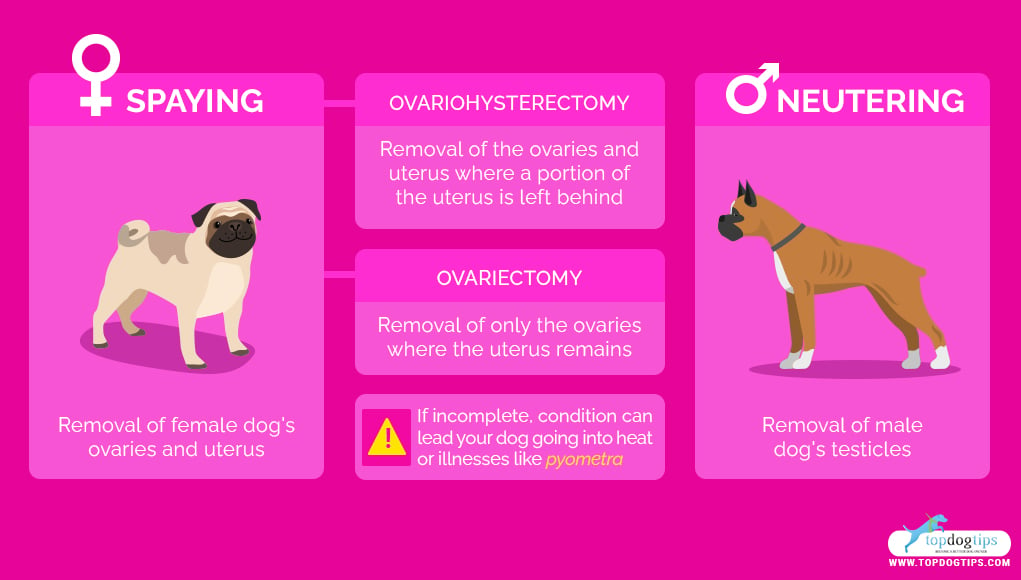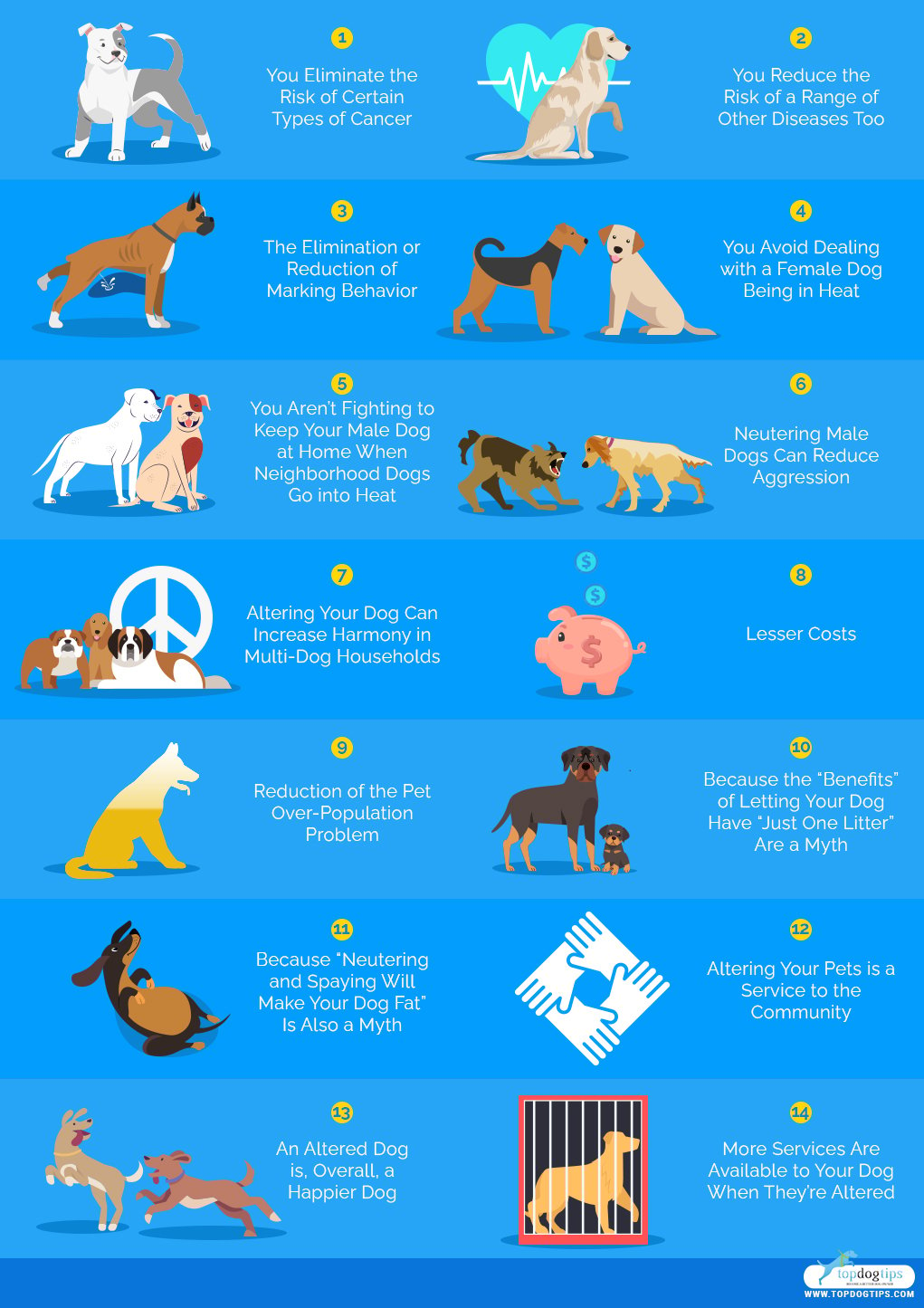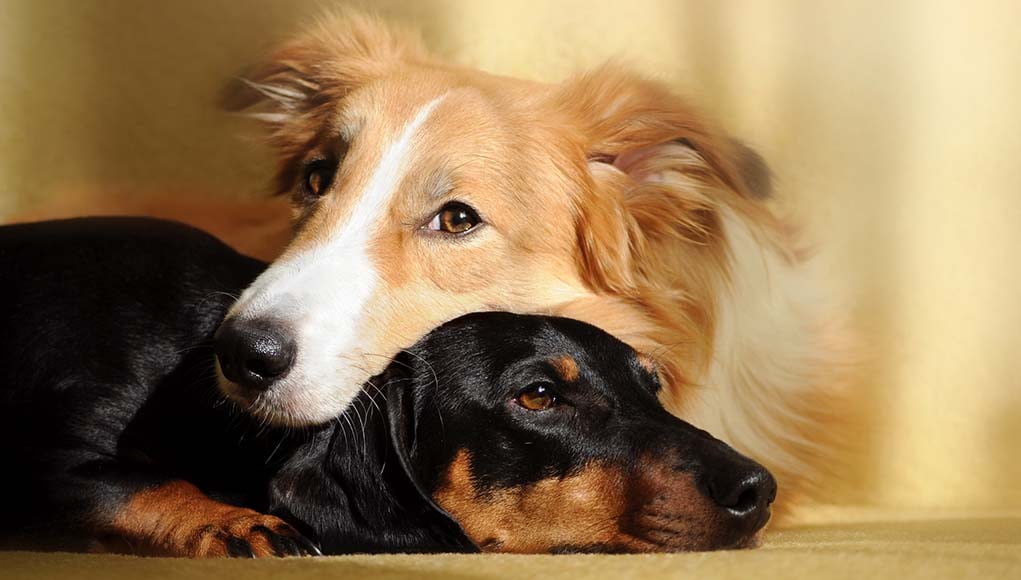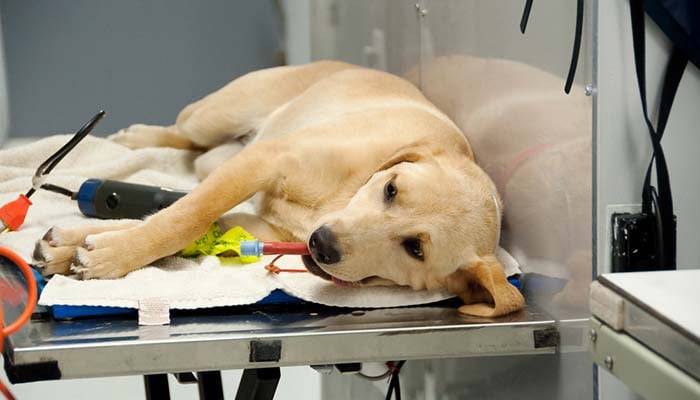Once you adopt a pup, spaying or neutering is often high up on the priority list for many pet owners. Still, not all are familiar with the many reasons why vets and rescue organizations recommend this. There is one obvious benefit of spaying and neutering your dogs – helping to reduce the pet overpopulation problem, but did you know that there are many other benefits too?

What's Spaying and Neutering?
Most of us understand the concept of spaying and neutering to mean sterilizing our dogs. Still, it’s important to understand exactly what this means to understand some of the health benefits that it delivers.
Spaying. When a female dog is spayed, her uterus and ovaries are removed not to become pregnant.
In some instances, a dog may have an incomplete ovariohysterectomy (removing the ovaries and uterus where a portion of the uterus is left behind) or an ovariectomy (removing only the ovaries where the uterus remains).
The incomplete removal of the ovaries can lead to symptoms associated with your dog going into heat.
The incomplete removal or complete failure to remove the uterus can also leave your female dog open to illnesses like pyometra.
Neutering. When a male dog is neutered, his testicles are removed through a de-sex procedure so that he cannot impregnate a female dog. The removal of a dog's gonads is called Castration.
While veterinarians do use both terms neutering and spaying, in most instances, only one of the – “neuter” – will be used as a term for removal of reproductive organs of dogs for both sexes.
Meaning that colloquially, the term “neutering” applies to both male and female dogs.
ALSO READ: Science on Pros and Cons of Neutering or Spaying Your Dog

Benefit of Spaying and Neutering Your Dogs
1. You Eliminate the Risk of Certain Types of Cancer
Spaying your female dog drastically cuts her chances of developing breast cancer – a disease with just a 50% survival rate in dogs.
Spaying also eliminates the possibility that your female dog will develop uterine, cervical, or ovarian cancer.
Similarly, neutering your male dog prevents them from developing testicular cancer.
2. You Reduce the Risk of a Range of Other Diseases Too
Spaying your female dog also eliminates or reduces the risk of developing pyometra, depending on their age of spay and the spay procedure.
Neutering your male dog also reduces the chances of them developing an enlarged prostate – in fact, if your male dog is neutered before hitting puberty, their prostate gland does not develop.
Neutered males also have less of a chance of perianal tumors.
3. The Elimination or Reduction of Marking Behavior
Unneutered dogs often tend to mark their territory with urine as an act of territoriality and dominance – yes, this includes inside the house.
In approximately 50-60% of cases, this marking behavior has been eliminated by simply getting the dog neutered.
4. You Avoid Dealing with a Female Dog Being in Heat
When people talk about wanting to breed their female dog, they tend to overlook that they will also have to learn how to manage a dog in heat.
A female dog in heat is messy, has behavior patterns that are out of the ordinary for them, may often try to escape, and will likely have irregular heat cycles for their first few cycles.
This creates several situations for you to deal with, from your dog bleeding and spotting to having to Macgyver your home to prevent repeated escape attempts.
None of these things are pleasant for you or your dog, and they can all be avoided by having her spayed before her first heat cycle.
And no, there is no reason why you should allow your female dog to go through her first heat cycle or have a litter before spaying her.
In fact, spaying your dog before she goes into heat virtually eliminates their lifelong risk of breast cancer (with the risk dropping to less than ½ of 1/10 of 1% (0.05%)), where allowing your dog to go through a single heat cycle before spaying her has a much lesser impact on their breast cancer risk.
5. You Aren’t Fighting to Keep Your Male Dog at Home When Neighborhood Dogs Go into Heat
When a female dog goes into heat, a male dog can smell her up to three miles away.
That means that if a female dog goes into heat within a three-mile radius, your male has a primal drive to seek her out and impregnate her.
Neutering your dog can reduce the testosterone in your male dog’s system and can eliminate or at least dampen that desperate need to mate so that you do not have to fight so hard against his hormonal wanderlust.
Keep in mind, though, that some neutered dogs will still have an interest in a female in heat despite being altered, so it’s always important to encourage spaying of female dogs as well.
6. Neutering Male Dogs Can Reduce Aggression
Although neutering is NOT a solution to aggression in dogs, male canines that are neutered at a young age exhibit less aggressive or dominant behavior than dogs that are not neutered.
This is caused by a lack of the testosterone surge that accompanies male dog maturity.
Neutered male dogs are also less prone to fighting with other male dogs as they have a lower drive to compete for mates and establish territory.
7. Altering Your Dog Can Increase Harmony in Multi-Dog Households
If you have more than one dog in your household, neutering your males can reduce conflict with other male dogs by decreasing testosterone levels, as I've mentioned above.
Altering your female dogs has a similar effect by eliminating the mood changes that often accompany a dog’s heat cycle and eliminating the source of frustration for male dogs in the household that occurs when a female is in heat.
8. COSTS!
Many dog owners severely underestimate the cost of having an unaltered do, so let’s take a quick look at just some of the potential expenses involved:
- If your unaltered dog is taken in by animal control, higher boarding fees, license fees, and release fees.
- The cost of products and care for a dog in heat.
- The cost of providing for a pregnant dog and whelping puppies. Not to mention any complications that may arise with the birth of the resulting puppies.
- Damages caused by an unneutered male dog attempting to get out to access a female in heat, marking your home with urine, or even biting someone else’s dog when asserting their dominance when a female in heat is nearby or when another male is vying for territory.
You can avoid all of this with a spay or neuter surgery that you can provide to your dog through a low-cost or no-cost spay and neuter clinic program.
9. Reduction of the Pet Over-Population Problem
Yes, I've already mentioned this point, and unless you’re living under a rock, you are well aware of it, but allow us to share a couple of devastating statistics with you to really hammer the point home.
According to the SPCA, 3.3 million dogs enter shelters across the U.S. in a single year. Around 670,000 of those dogs are euthanized each year.
Can you still justify adding to the 3.3 million shelter dogs that already need homes in this country alone?
10. Because the “Benefits” of Letting Your Dog Have “Just One Litter” Are a Myth
Many dog owners don’t spay or neuter their dogs because they falsely believe that allowing them to have “just one litter” is beneficial to their health.
This is not the case. In fact, we’ve already touched on how drastically you reduce your female dog’s chances of developing certain cancers with early spaying.
On top of that, there are also more risks associated with a female dog having a litter of puppies than having her spayed.
11. Because “Neutering and Spaying Will Make Your Dog Fat” Is Also a Myth
Another reason dog owners give for not spaying or neutering their dogs is that they believe altering them will make them “fat.”
There is simply no justification for this myth at all. Your dog will become overweight or obese because of inactivity, lack of exercise, poor diet – and not because you have altered them.
12. Altering Your Pets is a Service to the Community
One benefit that few dog owners realize to having their dog spayed or neutered is its impact on their community.
You are not adding to your local pet overpopulation problem, and so you are not draining state resources to care for even more homeless dogs.
You are also leaving more room in shelter facilities for stray dogs who may otherwise pose a hazard or nuisance to local drivers or pedestrians.
13. An Altered Dog is, Overall, a Happier Dog
It sounds silly, but it’s true! Your female dogs do not have to concern themselves with the affections of every male dog in a 3-mile radius when they go into heat, and your male dog isn’t constantly focusing on trying to get to every female dog in heat within that same range.
14. More Services Are Available to Your Dog When They’re Altered
It’s not a factor that many dog owners think about, but there are limitations on the types and costs of services available to your dog when they are not altered.
For example, boarding kennels often charge higher fees to board dogs that are not altered. Daycare programs will not accept dogs that are not altered. Training programs also have strict regulations on accepting unaltered dogs into their programs because of the distraction they can cause to other dogs sharing the same classes.
“But Why Can’t I….“
When sharing the benefits of spaying and neutering with someone reluctant to get their pet spayed or neutered, they undoubtedly have something to say. So do we…
Question: But why can’t I let my dog have a litter of puppies if I find them all homes?
A: Because those homes are homes that could provide for homeless dogs already living in shelters and facing euthanasia.
Statement: But I want another dog just like mine!
A: There is much more to your dog than its genetic makeup, and you can never replicate your existing dog no matter how hard you try. Also, remember that it takes two dogs to make puppies!
Question: Why is it anyone’s business if I’m caring for my dog and their puppies?
A: Because ultimately, you are still adding to the problem. You are taking homes away from dogs that will be destroyed due to a lack of homes simply by adding to the canine population.
It’s also the business of any dog lover to point out that irresponsible and inexperienced breeding creates unhealthy dogs that often wind up in shelters themselves when they become too costly to care for.
PODCAST: Pros and Cons of Spaying or Neutering Dogs
















